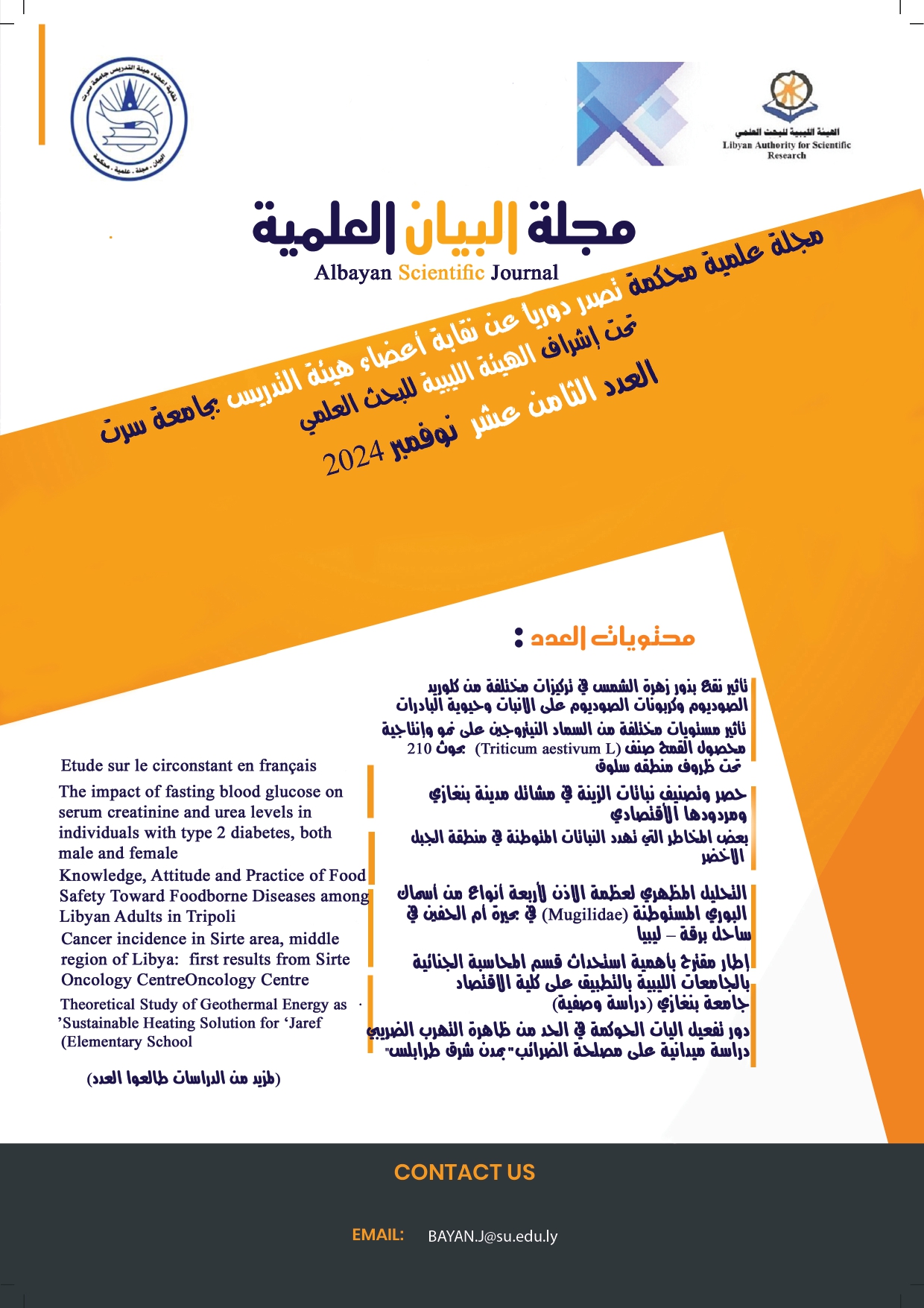وجهات النظر والمعوقان المرتبطة بإستخدام التعلم الإلكتروني كأداة تعليمية في تعلم اللغة بجامعة سرت
الكلمات المفتاحية:
التعلم الإلكتروني، أداة بيداغوجية، فصل اللغة، إنجليزي كلغة أجنبية، المشاكل والتحدياتالملخص
كانت هذه الدراسة محاولة لاستكشاف آراء الطلاب الليبيين حول استخدام التعلم الإلكتروني كأداة تعليمية في نعلم اللغة الإنجليزية بجامعة سرت. كما حاولت الدراسة معرفة العقبات التي يواجهها طلاب اللغة الإنجليزية كلغة أجنبية عند استخدام التعلم الإلكتروني. تألفت أداة البحث المستخدمة في هذه الدراسة من استبيان مغلق يتكون من عشرة بيانات وأسئلة، و12 بيانًا فرعيًا. عينة هذه الدراسة كانت تتألف من ثلاثين متعلمًا في اللغة الإنجليزية كلغة أجنبية تم اختيارهم عشوائيًا من كلية التربية، قسم اللغة الإنجليزية في جامعة سرت. تم جمع البيانات وتحليلها بشكل كمي. بناءً على نتائج هذه الدراسة، يمكن القول إن الطلاب يدركون أهمية استخدام التعلم الإلكتروني، إلا أنهم لا يحصلون على الفرصة المناسبة لاستخدامه لأسباب مختلفة. كما يمكن الاستنتاج أن الطلاب في جامعة سرت - كلية التربية يواجهون عدة عقبات وتحديات تربوية وتقنية عند استخدام التعلم الإلكتروني.
المراجع
Abernathy,D.(2019). ADDIE in action: A transformational course redesign process. Journal for the advancement of Educational Research,13(1).8-19.
Basilaia, G., & Kvavadze, D. (2020). Transition to online education in schools during a SARS-CoV-2 coronavirus (COVID-19) pandemic in Georgia. Pedagogical Research, 5(4).
Cojocariu, V. M., Lazar, I., Nedeff, V., & Lazar, G. (2014). SWOT analysis of e-learning educational services from the perspective of their beneficiaries. Procedia-Social and Behavioral Sciences, 116, 1999-2003.
Davies,G.(2012). Computer Assisted Language Learning: Where are we now and where are we going? Retrieved June 21,2016, from http://www.cam soft partners.co.uk/docs/UCALL-Keynote.htm
Littlefield, J. (2018). The difference between synchronous and asynchronous distance learning. https://www.thoughtco.com/synchronous-distance-learning-asynchronousdistance-learning-1097959
McBrien, J. L., Cheng, R., & Jones, P. (2009). Virtual spaces: Employing a synchronous online classroom to facilitate student engagement in online learning. International review of research in open and distributed learning, 10(3).
Murphy, M. P. A. (2020). COVID-19 and emergency eLearning: Consequences of the securitization of higher education for post-pandemic pedagogy. Contemporary Security Policy, 1-14. https://doi.org/10.1080/13523260.2020.1761749
Picciano, A. G. (2017). Theories and frameworks for online education: Seeking an integrated model. Online Learning Journal, 21(3). https://doi.org/10.24059/olj.v21i3.1225
Selinger,M.(2001). Communication Technology in Schools. ttp://www.imfundo.org/papers/cit-in-s.doc
UNESCO. (2020). Global Education Coalition-290- million students out school due-COVID-19. In Unesco. https://en.unesco.org/news/290-millionstudents-out-school-due-covid-19-unescoreleases-first-global-numbers-and-mobilizes
V. Singh & A. Thurman, How Many Ways Can We Define Online Learning? A Systematic Literature Review of Definitions of Online Learning (1988-2018), American Journal of Distance Education, 33(4), pp. 289-306 (2019). DOI: 10.1080/08923647.2019.1663082
Wang, H., Pi, Z., & Hu, W. (2019). The instructor's gaze guidance in video lectures improves learning. Journal of Computer Assisted Learning, 35(1), 42- 50. https://doi.org/10.1111/jcal.12309
Watson,Deryn. (2003). The Teacher- A Forgotten Stakeholder? In Dowling & K.Lai (Eds.), Information and Communication Technology and the Teacher of the Future (pp:29-38). Norwell, Mass.: Kluwer Academic Publishers.
Yang, F., & Li, F. W. B. (2018). Study on student performance estimation, student progress analysis, and student potential prediction based on data mining. Computers & Education, 123, 97-108. https://doi.org/10.1016/j.compedu.2018.04.006













